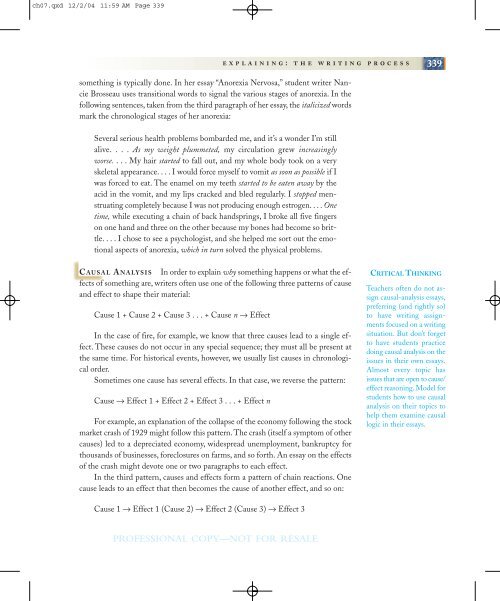A prolific painter of portraits before and after the French Revolution ...
A prolific painter of portraits before and after the French Revolution ...
A prolific painter of portraits before and after the French Revolution ...
Create successful ePaper yourself
Turn your PDF publications into a flip-book with our unique Google optimized e-Paper software.
ch07.qxd 12/2/04 11:59 AM Page 339<br />
explaining:<br />
<strong>the</strong> writing process<br />
339<br />
something is typically done. In her essay “Anorexia Nervosa,” student writer Nancie<br />
Brosseau uses transitional words to signal <strong>the</strong> various stages <strong>of</strong> anorexia. In <strong>the</strong><br />
following sentences, taken from <strong>the</strong> third paragraph <strong>of</strong> her essay, <strong>the</strong> italicized words<br />
mark <strong>the</strong> chronological stages <strong>of</strong> her anorexia:<br />
Several serious health problems bombarded me, <strong>and</strong> it’s a wonder I’m still<br />
alive. . . . As my weight plummeted, my circulation grew increasingly<br />
worse. . . . My hair started to fall out, <strong>and</strong> my whole body took on a very<br />
skeletal appearance. ...I would force myself to vomit as soon as possible if I<br />
was forced to eat. The enamel on my teeth started to be eaten away by <strong>the</strong><br />
acid in <strong>the</strong> vomit, <strong>and</strong> my lips cracked <strong>and</strong> bled regularly. I stopped menstruating<br />
completely because I was not producing enough estrogen. . . . One<br />
time, while executing a chain <strong>of</strong> back h<strong>and</strong>springs, I broke all five fingers<br />
on one h<strong>and</strong> <strong>and</strong> three on <strong>the</strong> o<strong>the</strong>r because my bones had become so brittle.<br />
. . . I chose to see a psychologist, <strong>and</strong> she helped me sort out <strong>the</strong> emotional<br />
aspects <strong>of</strong> anorexia, which in turn solved <strong>the</strong> physical problems.<br />
C AUSAL A NALYSIS In order to explain why something happens or what <strong>the</strong> effects<br />
<strong>of</strong> something are, writers <strong>of</strong>ten use one <strong>of</strong> <strong>the</strong> following three patterns <strong>of</strong> cause<br />
<strong>and</strong> effect to shape <strong>the</strong>ir material:<br />
Cause 1 + Cause 2 + Cause 3 ...+ Cause n → Effect<br />
In <strong>the</strong> case <strong>of</strong> fire, for example, we know that three causes lead to a single effect.<br />
These causes do not occur in any special sequence; <strong>the</strong>y must all be present at<br />
<strong>the</strong> same time. For historical events, however, we usually list causes in chronological<br />
order.<br />
Sometimes one cause has several effects. In that case, we reverse <strong>the</strong> pattern:<br />
Cause → Effect 1 + Effect 2 + Effect 3 ...+ Effect n<br />
For example, an explanation <strong>of</strong> <strong>the</strong> collapse <strong>of</strong> <strong>the</strong> economy following <strong>the</strong> stock<br />
market crash <strong>of</strong> 1929 might follow this pattern. The crash (itself a symptom <strong>of</strong> o<strong>the</strong>r<br />
causes) led to a depreciated economy, widespread unemployment, bankruptcy for<br />
thous<strong>and</strong>s <strong>of</strong> businesses, foreclosures on farms, <strong>and</strong> so forth. An essay on <strong>the</strong> effects<br />
<strong>of</strong> <strong>the</strong> crash might devote one or two paragraphs to each effect.<br />
In <strong>the</strong> third pattern, causes <strong>and</strong> effects form a pattern <strong>of</strong> chain reactions. One<br />
cause leads to an effect that <strong>the</strong>n becomes <strong>the</strong> cause <strong>of</strong> ano<strong>the</strong>r effect, <strong>and</strong> so on:<br />
CRITICAL THINKING<br />
Teachers <strong>of</strong>ten do not assign<br />
causal-analysis essays,<br />
preferring (<strong>and</strong> rightly so)<br />
to have writing assignments<br />
focused on a writing<br />
situation. But don’t forget<br />
to have students practice<br />
doing causal analysis on <strong>the</strong><br />
issues in <strong>the</strong>ir own essays.<br />
Almost every topic has<br />
issues that are open to cause/<br />
effect reasoning. Model for<br />
students how to use causal<br />
analysis on <strong>the</strong>ir topics to<br />
help <strong>the</strong>m examine causal<br />
logic in <strong>the</strong>ir essays.<br />
Cause 1 → Effect 1 (Cause 2) → Effect 2 (Cause 3) → Effect 3<br />
PROFESSIONAL COPY—NOT FOR RESALE

















